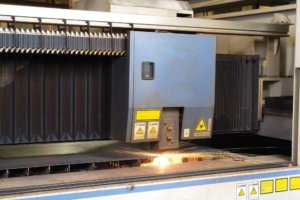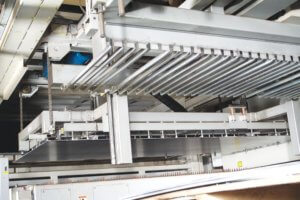Data Management in Metal Fabrication: Taming the Chaos
December 13, 2017
How one fabricator built a truly scalable business model.

A portion of the metal fabrication industry has reached a point Jeff Adams saw coming more than 10 years ago. The large OEMs have consolidated their supply bases. The result: More work goes to a smaller vendor base, and these top-performing few aren’t processing a handful of large orders that never change. They’re fabricating thousands of orders, and the requirements change continually.
This includes Adams’ company, Laser Precision in Libertyville, Ill. The company has invested heavily in shop floor automation, from offline bend programming to sophisticated laser cutting systems with material handling towers. All the same, Adams knew that investing in all this “hard” automation wouldn’t pay off if each process didn’t have the right information at the right time.
In one sense, Laser Precision really isn’t in the metal fabrication business. If it just offered a list of processes—laser cutting, bending, welding, assembly—it would be in the thick of the conventional battle, and have a difficult time scaling to the next level.
Instead, Laser Precision is really in the information management business. Specifically, the fabricator synchronizes customer data with manufacturing capacity so that when a customer triggers an order or any change to an order, that information is processed entirely automatically— with virtually no human intervention required.
The Automation Dream
In March of this year Adams spoke of the company’s transformation at The FABRICATOR’s Leadership Summit in New Orleans. He set the stage about what automation in metal fabrication promises, as well as the nightmare it can cause. “To be quite honest, automation can be a double-edged sword,” he said.
Fabricators automate to scale up capacity and reduce labor costs. A shop can increase production hours at a reduced variable cost, such as the cost of running a specific job through unattended machinery, versus the more expensive prospect of increasing the variable cost for labor and overtime. Capacity increases, sales per employee increases, morale increases, and so does employee compensation. That’s the dream. As Adams put it, “In short, manufacturing finally becomes viable again.”
Then comes the nightmare scenario, with highly advanced automated systems sitting idle as they wait for information, and people on the floor just waiting for something to happen. When the information does arrive, the automation jumps into action, churns out part after part, and people need to put in more overtime hours just to sort through it all. This creates massive piles of work-in-process (WIP) and finished goods; inventory skyrockets; labor costs escalate (thanks to that increased overtime); and the nightmare continues. The nightmare gets even worse if the information was incorrect, because that means the shop just wasted time and resources bending over backward to produce parts that weren’t needed in the first place.
“In this situation, you have misdirected capacity,” Adams said. “This happens because the automation doesn’t have the information necessary to be able to provide a smooth, productive environment. And we had those challenges.” Viewed this way, throwing automation into a shop without sophisticated data management is a little like grabbing a high-caliber rifle (big automated laser), shooting (throwing all the parts at it you can), and then aiming (poring over production reports and wondering why you’re losing money).

Who Nests the Parts? No One.
Laser Precision was an early adopter of automation. In fact, Adams once worked on the equipment side as national sales manager for Mitsubishi Laser at MC Machinery Systems, selling advanced technology to fabricators across the country. When he launched his shop in 1994, laser technology was really ramping up, and many knew it would not just dominate but shape the future of metal fabrication.
Unleashed from hard tooling costs, economic order quantities would plummet, and top fabricators would supply top OEMs with just what they needed, when they needed it, able to maneuver effortlessly with ever-more-volatile value streams. This would require not just advanced machinery, but also sophisticated information management.
In fact, not many years after launching his operation, Adams knew just how important effective data management would be. As he told a FABRICATOR magazine reporter in 2004, “The true challenge to automation is using it to meet customer needs effectively when handling so many more parts produced on the floor.”
Thirteen years later, at the 2017 FABRICATOR Leadership Summit, Adams spoke with the same sentiment. “I love automation. As early adopters, we enjoyed vast benefits in quality, velocity, and cost. It allowed us to grow. It allowed us to become who we are today, and made our business viable on a world stage. It’s a very critical element, but it needs to be done right. And from my perspective, the driving force behind it all is data.”
Walk into the office at Laser Precision, with its eight administrative employees, and you’d never guess the company manages more than 9,000 part numbers, more than 5,000 of them active. Most impressive, it manages an average of 1,875 order changes a day, and has between 130 and 200 shipments daily. This level of information processing makes the operation in 2004 almost sound quaint, when it managed “only” 300 to 500 order changes a day.
So with so many changes and so many orders—all transmitted electronically in what Adams called “walls of data coming at us”—how can programmers possibly nest everything?
Adams, of course, had the answer. “No one nests at our company. It’s all completely automated.” It has to be. To nest so many parts, manually or even semiautomatically, Laser Precision would need to employ an army of programmers, which of course wouldn’t be very cost-effective. The same holds true for the entire order-processing value chain. “We have zero schedulers and zero expediters. Everything is done by intelligent systems.”
No one spends their days keying in data. A customer sends an order via electronic data interchange (EDI). The enterprise resource planning (ERP) system, a customized version from OmegaCube Technologies, processes the order with the appropriate bill of material, then communicates that information to a nesting engine from SigmaTEK Systems and eventually to a production cell management system from Ncell. Within seconds, the order is created, prioritized, and dynamically nested with myriad other orders on a single sheet for maximum material utilization. The shop performs no static nesting whatsoever, and most laser work achieves more than 90 percent material yield.
Sheets are offloaded and move tickets with bar codes are applied to the appropriate flat parts. They must be to avoid chaos in downstream forming and welding. As soon as the job is finished, the operator clicks a button on a computer screen to notify the production system that the job is complete and on its way to forming. (Adams said eventually even this step will be automated, as open architecture allows machines to communicate directly with third-party production software and ERP.)

Building the Demand Profile
Fabricators live in a chaotic world. Where does the chaos come from? As Adams explained, “When OEM customers have complex value streams themselves, their MRP systems are constantly evaluating their requirements and refining their value stream. These small adjustments in planning and procurement are magnified throughout the value stream, often causing chaos for fabrication vendors.”
He added that modern value streams are interconnected. OEMs work with multiple suppliers, and suppliers work with other suppliers, making the supply chain less like a chain and more like a web. Say an OEM works with two suppliers, a machine shop and a fabricator, to supply components for a product. If the machine shop gets a week behind, that means the OEM doesn’t need parts from the fabricator until a week later as well.
“And historically, all these different elements in the value stream have been opaque,” Adams said. “They are difficult to identify and difficult to understand. And all of that taken together basically complicates automation and stifles agility.”
Herein lies the role of Laser Precision: to monitor, interpret, and manage the demand variability. Every one of the fabricator’s employees does this. “The guys making the parts need to know two things: what the customer wants and when they want it,” Adams said. “If they don’t know this, or if their information is not up-to-date, there’s a very strong chance we’re going to fail.”
Every part that’s processed has what the company calls an electronic demand profile, which includes up to 27 elements about that part that influence how and when that job is to be produced and delivered. These include geometry, labor requirements, processing times, effects on capacity, outsourced components or services, delivery schedules, and delivery quantities. Put simply, the electronic demand profile is a detailed description of what needs to happen to make a part successfully.
Every day the company downloads from customers their demand forecasts (which look up to 56 weeks ahead) and processes them through customized ERP modules. In about 45 minutes, the software reshuffles priorities and reschedules jobs. And at the last possible moment before cutting, it sends those jobs to the nesting engine and, finally, to the automated cutting machines.
The company takes on up to 175 new parts per month, and for each it builds an electronic demand profile. It classifies “new parts” as anything that introduces different manufacturing requirements and/or changes the allocation of shop resources. This can include anything from a simple material gauge change for an existing part to an entirely new job with unique routings and manufacturing requirements.
Whatever the change, “we need to reconstruct or reconfigure the demand profile to make that job successful,” Adams said. “We do this to avoid unexpected consequences.” This includes going through a production part approval process (PPAP), which helps build the foundation of the new electronic demand profile as the job heads into production. How long all this takes depends on the nature of the change.
The eight people in the office spend much of their day on this. They draw and change the design in 3-D CAD, run it through CAM simulation software (e.g., Dr. Abe for the company’s Amada press brakes, other CAM simulation software for its machining centers), run the new information through the company’s intelligent systems, and build a new electronic demand profile that the system can manage automatically and change daily.
Not for Every Shop
Adams conceded that this business model doesn’t apply to every type of fabrication business. It works only with customers who employ strategic sourcing models and disciplines. The jobs can change continually; that’s Laser Precision’s sweet spot, after all. (Theoretically speaking, if a job didn’t change for years, why not build a hard tool and stamp it?) All the same, a customer commitment and the infrastructure for EDI need to be there. Otherwise, it would be impossible to scale up the way Adams’ business has during the past 13 years.
Also, virtually automating the information flow didn’t occur overnight. The fabricator identified each problem and developed the “handshakes” between different software systems, including ERP, production control, and the nesting engine. It also developed safety and quality checks to make sure bad information didn’t find its way through the system. To get to its current state, Laser Precision basically had to look at the challenge like eating an elephant—taking one bite at a time.
Scaling Up
Today the fabricator employs 88 people who process 32,000 shipments a year, six times what was shipped in 2004. And although the shop had “only” 5,200 shipments 13 years ago, the company struggled with its on-time delivery, which was at 88 percent. Today it’s at 99.94 percent.
The fabricator processes five times the material tonnage, and overall manufacturing capacity has tripled compared to 2004. And yet, even with all this throughput, only 40 more people work at the shop since The FABRICATOR first visited the organization 13 years ago. Most significant: Even after all the growth—from a $4 million fabricator in 2004 to a $20 million enterprise in 2017—it still employs only eight administrative employees in the front office.
These numbers, Adams said, prove how well his team has scaled up the business. They’ve done it by taming the chaos to create orderly flow.

